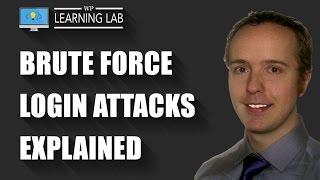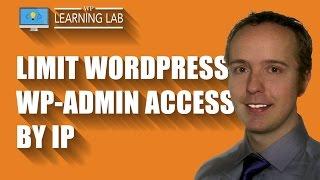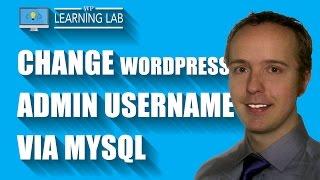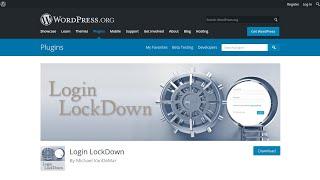Disable WordPress XMLRPC.PHP - Common Brute Force Hacker Exploit | WP Learning Lab - Best Webhosting
Thanks! Share it with your friends!
 ULTRAFAST, CHEAP, SCALABLE AND RELIABLE! WE STRONGLY RECOMMEND ACCU
WEB HOSTING COMPANY
ULTRAFAST, CHEAP, SCALABLE AND RELIABLE! WE STRONGLY RECOMMEND ACCU
WEB HOSTING COMPANY
Related Videos
-
Popular

Prevent PHP Execution In The WordPress Uploads Folder - Common Hacker Exploit | WP Learning Lab
Added 103 Views / 0 LikesGrab Your Free 17-Point WordPress Pre-Launch PDF Checklist: http://vid.io/xqRL Download our exclusive 10-Point WP Hardening Checklist: http://bit.ly/10point-wordpress-hardening-checklist Prevent PHP Execution In The WordPress Uploads Folder - Common Hacker Exploit | WP Learning Lab # BEGIN Stop PHP Execution in Uploads Folder Order Allow,Deny Deny from all (left pointy bracket)FilesMatch "^[^.]+\.(?:[Jj][Pp][Ee]?[Gg]|[Pp][Nn][Gg]|[Gg][Ii][Ff]|[Pp][Dd]
-
Popular

Brute Force Login Attacks Explained - Better WordPress Security | WP Learning Lab
Added 102 Views / 0 LikesGrab Your Free 17-Point WordPress Pre-Launch PDF Checklist: http://vid.io/xqRL Download our exclusive 10-Point WP Hardening Checklist: http://bit.ly/10point-wordpress-hardening-checklist Brute Force Login Attacks Explained - Better WordPress Security | WP Learning Lab #1 Biggest Security Threat Facing WordPress this year: http://bit.ly/WordPress-Security2 What is a Brute Force Attack? A hacker gains access to your website by guessing a correct usernam
-
Popular

Limit WordPress WP-Admin Access To Specific IPs - Keep Brute Force Hackers Out | WP Learning Lab
Added 117 Views / 0 LikesLimit WordPress WP-Admin Access To Specific IPs - Keep Brute Force Hackers Out | WP Learning Lab # BEGIN Restrict WP-Admin Access To Specific IPs Order Deny,Allow Allow from 123.456.789.111 Deny from all # END Block WP-Admin Access To Specific IPs In this tutorial I'm going to show you how you can disable wp-admin access to only IP addresses that you specify. This works great if you have a static IP or a known dynamic IP range that you always access t
-
Popular

Change WordPress Admin Username Via MySQL - Brute Force Attack Prevention | WP Learning Lab
Added 106 Views / 0 LikesGrab Your Free 17-Point WordPress Pre-Launch PDF Checklist: http://vid.io/xqRL Download our exclusive 10-Point WP Hardening Checklist: http://bit.ly/10point-wordpress-hardening-checklist Change WordPress Admin Username Via MySQL - Brute Force Attack Prevention | WP Learning Lab UPDATE wp_users SET user_login = 'Your New Username' WHERE user_login = 'Admin'; In this tutorial I'm going to show you how to change the Admin username on your WordPress accou
-
Popular

Password Protect Your WordPress Login Page - Brute Force Attack Prevention | WP Learning Lab
Added 104 Views / 0 LikesGrab Your Free 17-Point WordPress Pre-Launch PDF Checklist: http://vid.io/xqRL Download our exclusive 10-Point WP Hardening Checklist: http://bit.ly/10point-wordpress-hardening-checklist Password Protect Your WordPress Login Page - Brute Force Attack Prevention | WP Learning Lab # Password protect the wp-login.php file ErrorDocument 401 "Unauthorized Access" ErrorDocument 403 "Forbidden" (left pointy bracket)FilesMatch "wp-login.php"(right pointy brac
-

Limit Login Attempts Plugin - Use It To Stop Brute Force Attacks | WP Learning Lab
Added 100 Views / 0 LikesGrab Your Free 17-Point WordPress Pre-Launch PDF Checklist: http://vid.io/xqRL Download our exclusive 10-Point WP Hardening Checklist: http://bit.ly/10point-wordpress-hardening-checklist Limit Login Attempts Plugin - Use It To Stop Brute Force Attacks | WP Learning Lab The Limit Login Attempts WordPress Plugin is used to help prevent brute force login attacks. You can read more about this WordPress security plugin here: https://wordpress.org/plugins/l
-

Prevent Brute Force Attacks In WordPress in 2020
Added 93 Views / 0 LikesPrevent Brute Force Attacks In WordPress in 2020 https://youtu.be/Wt3Amy2PI3s //* Link to backup tutorial: https://youtu.be/566Zw8e84lE Link to Wordfence Tutorial : https://youtu.be/2F460uMt2JE Join our private Facebook group today! https://www.facebook.com/groups/wplearninglab //* The way you prevent brute force attacks in WordPress is by making your site more secure than the average. That means that your site is no longer the "low hanging fruit" tha
-

How To Limit The Login Attempts On WordPress For Free? Security To Prevent Brute Force
Added 30 Views / 0 LikesIn today's video tutorial, we'll learn a simple, fast, and effective way to prevent brute force attacks on your WordPress website by limiting the login attempts for free Why Has Online Security Never Been More Essential https://visualmodo.com/online-security-essential/ How To Add a Security Question To Login At WordPress Dashboard? https://www.youtube.com/watch?v=jQOPMPPBvjQ How To Hide WordPress Login Page From Public? Website Security Guide https://
-

WordPress Username Hack - Stop Hackers Finding Out Your Username By Brute Force
Added 76 Views / 0 LikesGrab Your Free 17-Point WordPress Pre-Launch PDF Checklist: http://vid.io/xqRL Download our exclusive 10-Point WP Hardening Checklist: http://bit.ly/10point-wordpress-hardening-checklist WordPress Username Hack - Stop Hackers Finding Out Your Username By Brute Force Ever since WordPress 3.0 webmasters have had the ability to choose their own usernames when installing WordPress, which helps in reducing the number of successful brute force login attacks
-
Popular

WordPress Login Lockdown Stops Brute Force Attacks On The Login Page
Added 123 Views / 0 LikesGrab Your Free 17-Point WordPress Pre-Launch PDF Checklist: http://vid.io/xqRL WordPress Login Lockdown Stops Brute Force Attacks On The Login Page https://youtu.be/KdN98CtXtiA Plugin in repo: https://en-ca.wordpress.org/plugins/login-lockdown/ Wordpress Login Lockdown is a brute force hacking security plugin. It will help reduce the chances of a brute force attach being successful. It is very similar to Limit Login Attempts Reloaded with one importan
-

How To Remove The WordPress Version Number From Your Site - Hacker Proofing | WP Learning Lab
Added 94 Views / 0 LikesGrab Your Free 17-Point WordPress Pre-Launch PDF Checklist: http://vid.io/xqRL Download our exclusive 10-Point WP Hardening Checklist: http://bit.ly/10point-wordpress-hardening-checklist How To Remove The WordPress Version Number From Your Site - Hacker Proofing | WP Learning Lab remove_action('wp_head', 'wp_generator'); //Remove WordPress version from site In this tutorial you're going to learn how to remove the WordPress version number (WordPress ge
-
Popular

Protect Your WordPress WP-Config.php Via .htaccess - Hacker Proofing Your Site | WP Learning Lab
Added 101 Views / 0 LikesGrab Your Free 17-Point WordPress Pre-Launch PDF Checklist: http://vid.io/xqRL Download our exclusive 10-Point WP Hardening Checklist: http://bit.ly/10point-wordpress-hardening-checklist Protect Your WordPress WP-Config.php Via .htaccess - Hacker Proofing Your Site | WP Learning Lab # BEGIN Protect the wp-config.php file (left pointy bracket)files wp-config.php(right pointy bracket) order allow,deny deny from all (left pointy bracket)/files(right poin










